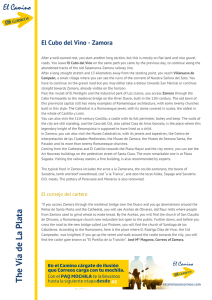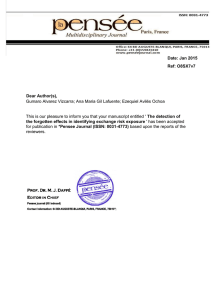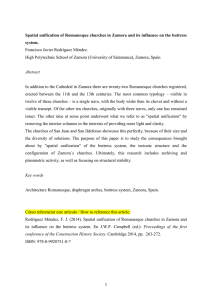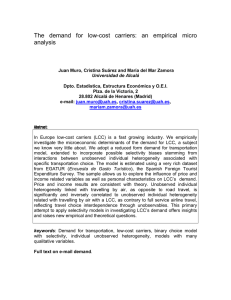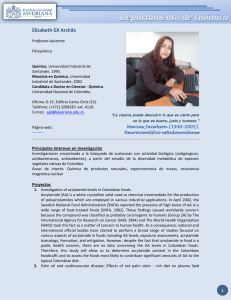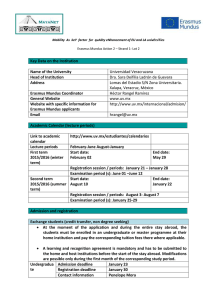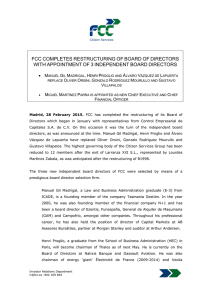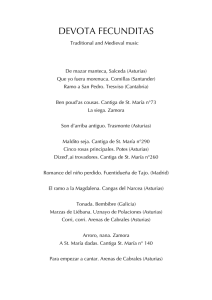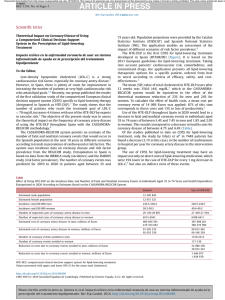Studies on Medieval Spain and Christendom in Memory of Richard
Anuncio
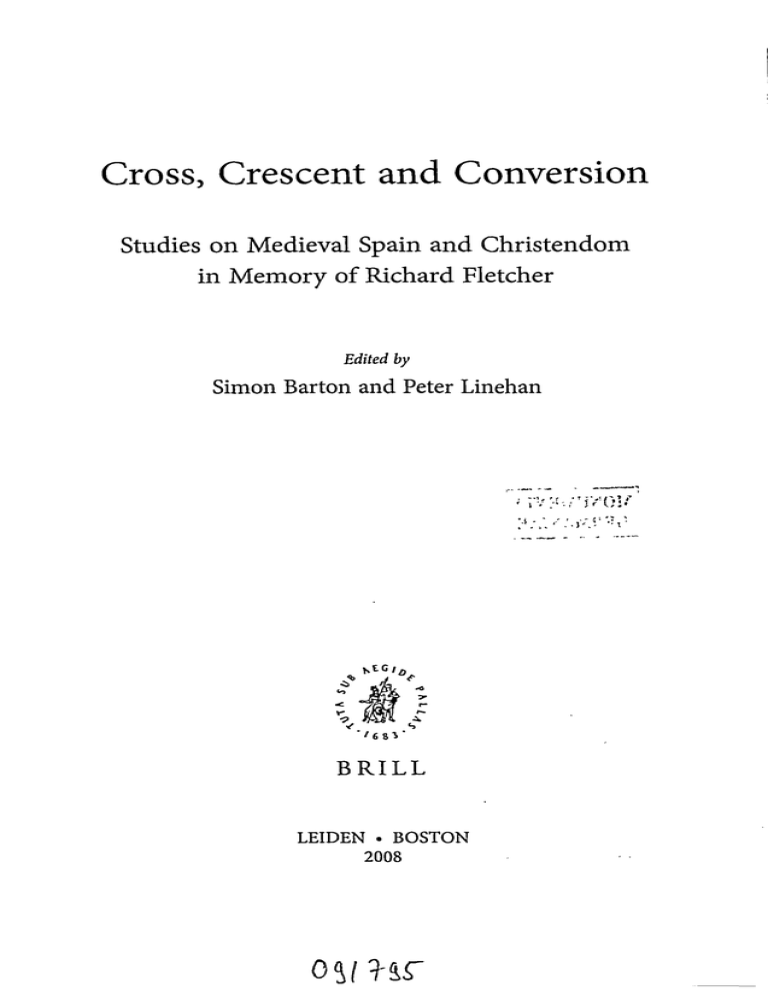
Cross, Crescent and Conversion Studies on Medieval Spain and Christendom in Memory of Richard Fletcher Editedby Simon Barton and Peter Linehan ý 'ý., ý,,r,, 'ir't:: ý . BRILL LEIDEN " BOSTON 2008 () s( 3-ý5 '}. ,... j:, +` ; t" COLUMPNA FIRMISSIMA: D. GIL TORRES, THE CARDINAL OF ZAMORA' Peter Linehan (University of Cambridge) In November 1254 D. Gil Torres, the cardinal of Zamora, died someNaples Pope Italy, in Innocent IV was at the at perhaps where where time-or perhaps not, since, even if not almost a centenarian, as one 2 contemporary would allege, after thirty-eight years in the service of the by he be in then to state almost certainly no was carted round papacy with an itinerant court. The reports that we have of his demise come not from a Zamoran from Obituarios They the of the cathedral churches of come source. Burgos and Toledo? Nor does Zamora, where Richard Fletcher and the have both their teeth, archival cut any street or square present writer named after one of its most notable sons, who at the time of his death was the second most senior cardinal, and over time that neglect, or indifference, which the pope who raised him to the purple commented has Zamoran the than allowed once, cardinal to be claimed on more by other places. According to Luciano Serrano, as well as "doctor en derecho" D. Gil was burgales,"originario de Bureva. But for this asserSilos his learned offered of no proof, the abbot and tion misreporting "sobrino del de hardly Valladolid" Torres abad as encourages of another Torres hardly 4 In less the case, apellido was any common confidence ' This is a revised version of a paper read in Spanish at the 2° Congreso de Historia de Zamora in November 2003. My warm thanks are due to Sr. Jose Carlos de Lera Maillo, archivist of Zamora cathedral, for all manner of kindnesses. 2 Seebelow, p. 257. 3 Reporting the date as 11 November: Luciano Serrano, El obispado de Burgos, y Castilla primitiva desdeel siglo V al XIII, 3 vols. (Madrid, 1936), 3:391. The Toledo Obituario says5 November (for "Egidius cardinalis, huius ecclesiecanonicus"): Toledo, Biblioteca Capitular, MS. 42-30, fol. 133v But the Toledo Obituario is unreliable, with the obits of various fourteenth-century cardinals (for example) wrongly given. 4 Luciano Serrano,D. Mauricio, obispode Burgosy fimdador de su catedral, (Madrid, 1922), p. 70 and n. 1. The source cited-Manuel Manueco Villalobos and JoseZurita Nieto, Documentosde la iglesiacollegial de Santa Maria la Mayor (hoy Metropolitana) de Valladolid. Siglo XIII (1201-1280) (Valladolid, 1920), p. 150-refers to Johan de Torres as "merino del Abbat". 242 PETER LINEHAN in thirteenth-century Burgos than the nombre Egidius. The most that can be said for sure about D. Gil's connexion with Burgos is that at the time of his promotion in 1216 he was an archdeacon of that church, a dignity he had acquired sometime between March 1209 and November 1210 .1 Despite the gift of tithes made in 1218 to the Portuguesebishops by their king, Afonso II, "pro amore magistri Egidii cardinalis;" his alleged Portugueseorigins are equally dubious. Like those of the Leonese Cardinal Ordono Alvarez of the next generation, they are attributable to Portuguesecultural colonialism of the seventeenthcentury.6 The reason for regarding D. Gil as zaniorano is twofold. First there is the fact that whereashis bequeststo the church of Burgos were for anniversariesfor himself,' those at Zamora were also for his nearest and dearest,his parents and his sister, though at modest cost in comdaily his the commemoration of himself parison with expenditure on there! And although, by contrast with his senior Leonese colleague, Cardinal PelayoGaitän, he did not possesssufficient local property for the purpose,9suggestingthat by the date of theseendowmentshis mate- 5 Jose Manuel Garrido Garrido, Doaunentaciön de la catcdral do Burgos (1154-1222) (Burgos, 1983), nos. 410,430; Les Registres d'Lmocent IV [hereafter Reg. Inrz. IVj, ed. Elie Berger, 4 vols. (Paris, 1884-1921), no. 4436. 6 Antonio Domingues de SousaCosta "pro amore magistri Egidii cardinalis": idern, Mestre Silvestree dfestre tiicente, juristas da contenda entre D. Afonso 11a suns irrniu (Braga, 1963),pp. 67,69; Peter Linehan and Margarita Torres Sevilla, "A Misattributed Tomb and its Consequences.Cardinal Ordono Alvarez and His Friends and Relations," Rivista di Storia delta Chiesain Italia 57 (2003), 53-63 at pp. 55-6; Antonio Domingues de SousaCosta,"Cultura medieval portuguesa.Portugues,o Cardeal Gil?;' Itincrariunz 1 (1955), 296-306 at pp. 303-6. ES 26 (Madrid, 1771), pp. 323-5; Serrano, Obispado de Burgos, 3: 391. 8 For this, and the testimony of Juan Gil de Zamora OFM, see Peter Linehan, The Spanish Church and the Papacy in the Thirteenth Century (Cambridge, 1971), P. 277; Zamora, Archivo de la Catedral (hereafter ACZ], 12/1; ACZ, Tumbo Negro [hereafter TN], fol. 131r-v (Jose Carlos de Lera, Catdlogo de los documentos nicdievales dc la catedral de Zamora (Zamora, 1999) [hereafter Lera], nos. 370,373): eighteen aurei as against six hundred. Details have not survived of the original endowment of the anniversary on 4 May recorded in the 16th-century Zamora Obituario (ACZ, MS. 211, fol. 21v; Lera, no. 2332): "Yten aniversario por el cardenal don Guillen [sic] cient maravedis con missy cantada al altar mayor. laze en Roma. CVI maravedis" "Possessionemaliquam ydoneam usquead sexcentosaureosalfonsinosad arbitrium venerabilis patris Zamorensis episcopi qui nunc est volumus comparari": ACZ, TN, fol. 131v.Cf. the housesin Leon assignedto the same purpose by Cardinal Pelayo in 1230:JoseMaria FernandezCaton, Coleccibndocumental del Archivo de la Catedral de Leon (775-1230) [hereafter CDACL] (Fuentesy Estudios de Historia Leonesa),6 vols. (Leon, 1987-91), 6: no. 1966.Pelayosbequest was made at the end of his life. D. Gil's is undated. Lera'sproposal of the year 1223 requires reconsideration. COLUMPNA FIRRfISSIMA 243 links with Zamora were tenuous, the terms in which, on successive rial occasions,Honorius III rebuked the zamoranos for their reluctance to oblige D. Gil by accommodating his clients, cannot be ignored. If only the chapter of Zamora had reflected on the benefits that their association with the cardinal would bring them-the pontiff reflected in May 1218, in words which D. Gil himself may have supplied-rather than ignoring papal mandateson behalf of such people for promotion in their church, they would be falling over themselves to anticipate his wishes.10Honorius's register contains two further letters, framed in almost identical terms, on behalf of one or other of the cardinal's clients." And of such clients, many of them the cardinal's nepotesand consanguinei for whom he secured papal support, there was to be no end over the coming decades.To one of them in particular, his neposdilectissimus Master Esteban de Husillos, I shall return. From information contained in the papal registers it might even be family his to tree.12What is certain is that family reconstruct possible tree included two bishops of Zamora, both named Pedro,who occupied the seebetween 1239x124313 and 1255and 1286 and 1302 respectively. The second of these (Pedro Benitez before his promotion), was the neposnot only of Cardinal Gil and Estebande Husillos (whose copy of the Gregorian decretals he disposed of in his will) but also of Bishop 10 Pietro Pressutti, Regesta Honorii Papae III [hereafter Reg. Hon 111], 2 vols. (Rome, 1885-95), no. 1277 (ed. Demetrio Mansilla, La documentation ponticia de Honorio III (1216-1227) [hereafter MDH] (Rome, 1965), no. 169). Cf. the letter in the formulary of Thomas of Capua (datable from its context to 1218 x 1221 on behalf of "P.; a nephew of Cardinal Pelayo, urging the church of Leon "quatinus quem ad patruum geritis in nepote monstretis affectum": Simon Fridericus Hahn, Collectio monvmentorvm, vetervm et recentivm, ineditorum, ad codicvnhfrdem restitutorvm, selectorvm, et rariorvm dipiomatvnh litterarvm, d: sigillorvm, ronicorvnl, aliorvinque insignivm scriptorvm, Antiquitates, nempe historian: onmem, ac nobiliores ivris part es havd inediocriter illvstrantivm, geographiam, 2 vols. (Bruns+ick, 1724-6), 1:383-4; Linehan, Spanish Church, pp. 291-2. 11Reg.Hon III, nos. 2405,4878 (MDH, nos. 277,498). 12Francisco, "nepos. son of Teresa,herself allegedly the cardinal's "nepta'; Rodrigo Dominguez, "consanguineus"; Johannes son of Rodrigo Tomas, "consanguineus"; Sancho Alfonso, "nepos; all dating from the years 1252-54: Reg. Inn. IV, nos. 5808, 6696,6870,7710. 13Concerning the reasonsfor Pedro I's differing status in the estimation of papal and five during these years,see Peter Linehan, "An impugned chirograph and courts royal the juristic culture of early thirteenth-century Zamora": Mario Ascheri and Gaetano Colli (eds.), Manoscritti, editoria e biblioted: e dal Mfedio Evo all'Etd contemporanea. Studi offerti a DornenicoMaffei peril suo ottantesimocompleanno,3 vols. (Rome, 2006), 1:461-513 at pp. 475-6. 244 PETER LINEHAN Pedro I, " while the fact that the latter ("Petrus Bonus": Peter the Good) by is the cardinal's nepotes confirmed some English was yet another of " to shall return. evidence which we So the cardinal was a member-perhaps a founding member-of one of those episcopal dynasties with which the kingdom of Castile-Leon during his One thinks in particular of the see century. supplied waswell four five Cuenca, if Burgos that not of whose thirteenthof of of and famil}: 16 bishops Indeed, one may of a single were members century even think of Zamora itself where for more than forty years during the twelfth century the seehad been governed by Bishops Esteban and Guillermo who, as well as probably being French, were also certainly uncle and nephew;" and where in the thirteenth D. Suero Perez, who was electedin February 1255,just three months after the cardinal'sdeath, have been regardedby the cardinal'sconnexion as an would accordingly intruder. " In 1216,however,the date of Cardinal Gil's elevation,Zamora had a pastor whose origins were Galician, namely Martin Arias, Bishop Martin 1.11And at the date of Cardinal Gil's elevation in 1216 Bishop Martin's pontificate was in the processof drawing to an untidy close. " Idem, The Ladies of Zamora (Manchester, 1996), p. 86; Reg.Inn. M. nos. 5564, 5805; JoseCarlos de Lera Maiillo, "El testamento del obispo de Zamora Pedro II, aiio 1302. Edition diplomätica" Homenaje a Antonio Matilla Tascon(Zamora, 2002), pp. 355-60. 15ACZ, 31/11/1 (Lera, no. 536), April 1247); Linehan, Spanish Church, p. 294n.; below, n. 78. 16Francisco Javier Hernandez and Peter Linehan, The Mozarabic Cardinal. The Life and Timesof GonzaloPerezGudiel (Florence, 2004), pp. 19,42 and referencesthere. 17Witness the testimony of "Rodericus presbiter et canonicus Bracarensis" (ante 1193) concerning Bishop Estebans tearful deathbed repentance in 1175 for having failed in his obedience to the archbishop of Braga: "et dixit [Rodericus[ quod ille episcopus tune dixit cuidam suo sobrino qui nunc est episcopus Zamorensis: 'Et tibi dico quod si forte Deus dederit tibi episcopatum Zamorensern ut Bracarensi ecclesie debeas obedire. Predicto episcopo mortuo, electus fuit ille sobrinus eius.. ": Lisboa, Instituto dos Arquivos Nacionais Tone do Tombo [hereafter IANTT], Coleccio Especial, Mitra de Braga, cx. 1, no. 2. I owe this information to the kindness of Richard Fletcher. Cf. Peter Feige, "Die Anf"ange des portugiesischen Königtums and seiner Landeskirche" Spanische Forschungen der Gärresgesellsdiaft, 1. Reihe. Gesammelte At fsätze zur Kulturgeschichte Spaniens 29 (1978), pp. 318-23,383-5. 11Peter Linehan, "The Economics of Episcopal Politics: the Cautionary Tale of Bishop Suero Perez of Zamora, The Processes of Politics and the Rule of Law. Studies on the Iberian kingdoms and Papal Rome in the Middle Ages (Aldershot, 2002), item V, pp. 6-9. 19Richard A. Fletcher, TheEpiscopatein the Kingdom of Leon in the Twelfth Century (Oxford, 1978), p. 44. COLUMPNA FIRMISSIMA 245 With these considerations in mind, let us return to the papal letter for have it May 1218, may more to tell us than first appears.In it of Honorius III statesthat he had already required the chapter of Zamora to confer the deanery upon the cardinal's brother. But they had failed to oblige. He now instructs the new bishop-Martin Rodriguez (Martin II)-to award him the archdeaconrythat was vacant 20But the cardinal's brother was no more successfulon this occasionthan on the last: Under Martin II, who had come to Zamora from Leon and who returned there as bishop in 1238,21there was no archdeacon of Zamora with a name beginning with "P'=2 Of course,one might regard such flagrant contempt of papal instructions as just another example of that overweening peninsular selfconfidence that historians have observed in action in the years after the battle of Las Navas de Tolosa, particularly in the writings of the Hispanus. It Vincentius was at this very time, indeed, in glosscanonist ing a decretal of Alexander III-addressed as it happened to a bishop of Zamora (D. Guillermo) who had defied the summons of a papal legate, having himself lied him, had to then as as well consecratedwhile and "Why did Vincentius the pope asked rhetorically: excommunicate-that did he behaviour him? Why depose tolerate such and dispensehim?;" not he "Because "23 Spaniard! the was answer: with a up and came But in the present case the concerted defiance of bishop and chapter may be symptomatic of something more specific, namely schism within the chapter of Zamora itself in the transition from the rule of Bishop Martin I to Martin II between 1217 and 1219. In the final months of Innocent III's pontificate Martin I had requested and had been granted he his Then had it the to see. changed resign mind-or permission by forces for him within the chapter, other members of which changed later reported to Honorius III that in consequence the church was "tam in temporalibus quam in spiritualibus multipliciter (... ) collapsa," with 21 Reg. Hon. III, no. 1277 (above, n. 10). 21 Les Registres de Gregoire IX [hereafter Reg. Greg. IX], ed. Lucien Auvray, 4 vols. (Paris, 1890-1955), no. 4594: Santiago Dominguez Sanchez, Documentos de Gregorio IX (1227-1241) referentes a Espana (Leon, 2004), no. 803. 22 The earliest appearance in the record of Pedro Perez, archdeacon of Toro, is in June 1241: ACZ, 16/II/50 (Lera, no. 513). 2' "Gratia yspanorum dicamusspecialis,uel est maxima dispensatio":cit. JavierOchoa Sanz, Vincentius Hispanus, canonista boloiies del siglo XIII (Rome-Madrid, 1960), p. 15,21,123. Cf. Peter Linehan, History and the Historians of Medieval Spain (Oxford, 1993), pp. 296-7,637. 246 PETER LINEHAN him June to within 1217 the that the result pope positively required draw24Yet although the royal chancerywas already describing Martin II it by date, bishop-elect in the that was not until record capitular as May 1220 that he figured as bishop.23Indeed throughout those three bishops between Martin the capitular record two the years of obscurity is strangely silent, and during it the chapter'ssenior personnel had all been replaced,26with none of those who had profited in the process being a client or relation of the pope'sprincipal advisor on all matters Zamoran, namely the cardinal of Zamora himself. One thing most of these new men shared was a juristic training because,partly no doubt on account of the expertise of the two bishops Martin, early thirteenth-century Zamora was one of the peninsula's less 27 Juristic juristic the cause though was expertise centres principal of this distinction than a symptom of Zamoras situation on the frontier with Portugal. At a time when successivekings of Portugal were beastly Rome their of reportedly with on account so regularly at odds treatment of their bishops,Zamora was the safestcentre from which to attempt to exercisecanonical control, as well as providing a haven for Portuguesebishops in exile? This was a development that had been 2aReg.Hon. III, no. 629 (MDH, no. 64). Innocent III's permission must have been granted later than 6 Feb. 1216:Demetrio Manilla, La docurnentaci6npont jcia pasta InocencioIII (Rome, 1955),542. 25Julio Gonzalez,Alfonso IX, 2 vols. (Madrid, 1944), 2:483, no. 369; ACZ, TN, fol. 96r (Lera, no. 330). 26 Dean Juan made his will in June 1217 (ACZ, TN, fol. 88r-v: Lera, no. 305) and between Sept. 1217 and Feb. 1219 was replaced in that office by Florencio, archdeacon of Zamora (ACZ, 17/37, Archivo Histörico Provincial de Zamora, pergaminos, 1/15: Lera, nos. 308,317). In the same period Master Juan replaced Munio Aluniz as archdeaconof Toro, and by Aug. 1221 the archdeaconry of the city had passed to D. Isidoro (ACZ, 36/4: Lera, no. 342). 27 For the former's glossesto the Decretum, see Stephan Kuttner, Repertorium der Kanonistik (1140-1234): Prodroinus corporis glossanun;Studi e Testi 71 (Vatican City; 1937), pp. 11,53; for the latter's to "Compilatio I" and his Notabilin to "Compilatio IV," idem, "Bernardus Compostellanus Antiquus, Traditio 1 (1943), 277-340 at p. 335; Antonio Garcia y Garcia, "La canonistica iberica medieval posterior at Decreto de Graciano; Repertorio de las CienciasEclesidsticasen Espana 1 (Salamanca, 1967), pp. 397-434, at p. 412. 28 As evidenced by the depositions of witnessesarraigned at a hearing in 1252 of the dispute between the bishop and chapter of Coimbra and Santa Cruz dc Coimbra relating to theseyears:"Interrogatus in quo loco fuit tempore exilii episcopus,respondit quod Zamore et in curia Romana7;"Interrogatus super alio articulo qui sic incipit "Item quod episcopusfuit exul etc", dixit quod nescit, audiuit tarnen quod multo tempore fuit in curia et Zamore et non erat ausus uenire ad regnum propter regem et de hoc Brat publica fama : IANTT, Cabido da Se de Coimbra, 14incorporac-ao.docs. particulates, cx. 26, rolo 4, membranas 8,12. i I COLUMPNA FIRMISSIMA 247 facilitated by Innocent III's acquiescencein the detachment of the see of Zamora from the metropolitan authority of the church of Braga, a subject on which Richard Fletcher wrote such persuasive pages.29 For this and no doubt other reasons, in the first three decades of the thirteenth century Zamora was arguably the principal centre of juristic activity in the Spanish peninsula, with its chief practitioner the archdeacon, later dean, D. Florencio. 30From this milieu Cardinal Gil emerged. Dominus Egidius in December 1206; by March 1209 he had acquired the title Magister. 31And although at this date the title Magister did not necessarily imply attendance either at Bologna or indeed at any other legal academy, 32there are other possibilities. One of these of course was Palencia. But there were others, Coimbra, Calahorra and Osma, to the last of which the celebrated Portuguese canonist Master Melendus came from Rome as bishop in 1210. Although the Master Melendus who was alongside our Master Egidius at Burgos in March 1209 was almost certainly not the episcopal Melendus, 33it can be demonstrated that the episcopal Melendus had been at Palencia at or shortly before that date. Moreover, Zamora lies on the road between Coimbra, from whose Augustinian church of Santa Cruz Melendus seems to have emerged, and Osma, where he ended his days 34 It is possiblethat the future cardinal'scursusstudiorum paralleled that 35 Moreover, since the Roman reputation of Gil Torres was Melendus of such as to merit advancementwithin the first six months of Honorius III's pontificate (though not, be it noted, to be included in Innocent III's promotion of cardinals in the previous year), a possible explanation for his absencefrom the Burgos record after November 1210 (and perhaps the most likely) is that he was at Rome on capitular business,36that he 29 Manilla, Inocencio 111,no. 199; Fletcher, Episcopate, pp. 195-203. 3° See Linehan, "An Impugned Chirograph, pp. 467-71. 31 Garrido, Docutttentacir n de Burgos, nos. 392,410. 32 Olga Weijers, Terminologie des universites au XIII` siecle (Rome, 133-42. 1987), pp. 31 Garrido, Docutttentaciönde Burgos,nos. 410-11. Cf no. 471, "domnus Melendus decanus" (April 1214). 1i Peter Linehan, "D. Juande Soria: tarnsapostillas," Fernando III y su tiempo (12011252): VIII Co»gresode EstudiosMedievales(Leon, 2003), 375-93 at pp. 386-7; Ingo Fleisch, Sacerdotiuttt-Regttuttt-Stttditt» t. Der westiberischeRaum und die europäische Universitätskultur irrt Hoclunittelalter (Berlin, 2006), pp. 120-7. 35 Ibid., pp. 238-9. J6 As capitular or episcopal proctor in relation to litigation against the collegiate church of Castrojeriz and the abbey of Ona, as surmised by Serrano, D. Mauricio, pp. 70-1; Garrido, Docume»taciön de Burgos,no. 430. 248 PETER LINEHAN for Council November Fourth Lateran in 1215,and the there remained that it was then that he caught somebody'seye" Once installed in Honorius III's curia, Gil Torres assumed a low by he listed April Sometime in 1217 the a Roman was year after profile. "who Philip Augustus the one of cardinals are attached to of as agent (qui diligunt) King Frederick (i. e. the young Hohenstaufen emperor(i. king lord France the e. the ageing Philip Augustus)'3S of elect) and But there was nothing surprising about that. In 1217, after all, as well (Dona being Blanca: Castile Blanche of Castile) Infanta there of an as installed at Paris as queen-consort in waiting, there was also the same lady's nephew in the processof ascendingthe throne of Castile (as King Fernando III) and awaiting delivery of his Hohenstaufen bride. The English diplomatic records of the following decaderefer to the cardinal occasionally, but only very occasionally:39Unlike his senior Spanishcolleague,Cardinal Pelayo,and his junior, Cardinal Guillermo the former abbot of Sahagün,Gil Torres did not become involved in diplomatic missions abroad40 Rather, he remained at the curia, active as an auditor of disputes, sometimes in combination with Cardinal Pelayo,until the latter's death in 1230.But it would be too wearying to repeat here the details of these that are recoverable from the Vatican " Although, admittedly, documentary confirmation of his attendanceis lacking, we may regard Bishop Melendus,who waspresent (JuanFrancisco Rivera,"Personajeshispanos asistentesen 1215al IV Concilio de Letran, Hispania Sacra4 (1951), 335-55 at p. 343) as at least as likely to have advancedhis career as the LeoneseCardinal Pelayo and the PortugueseHospitaller "frater Gundisalvus Hispanus" who have been credited with doing so: Serrano,loc. cit., whenceAmancio Blanco Diez, "Los arcedianosy abades del cabildo catedral de Burgos," Boletin de is Real Academia de la Historia 130 (1952), 267-98 at pp. 273-5. Be it noted that fr. Gundisalvus, papal factotum in the Spanish kingdoms and Portugal since at least 1213,was to be appointed sacrist of Osma during Melendus' pontificate, despite his membership of the Order of the Hospital: Linehan, "Juan de Osma, pp. 384-5; Fleisch, Sacerdotiwn, p. 239. However, the dedication by Joao de Deus of his "Notabilia cum Summis super titulis Decretalium" to Gil Torres and Joaös description of himself as the cardinal's "humilis clericus" (Costa, "Cultura medieval portuguesa," pp. 299-300) are neutral witnessesas to Gil's relationship with Melendus. 38 Robert Davidsohn, 1888), pp. 318,320. Philipp 11. August von Frankreich and Ingeborg (Stuttgart, 39 Pierre Chaplais (ed.), Diplomatic DocumentsPreservedin the Public Recordoffice, vol. 1,1101-1272(London, 1964),nos. 153,194.For further details seeWerner Maleczek, Papst and Kardinalskollegvon 1191 bis 1216 (Vienna, 1984), pp. 144,265. 40 Cf. JamesM. Powell, Anatomy of a Crusade, 1213-1221 (Philadephia, 1956); Augusto Quintana Prieto, "Guillermo de Taillante, abad de Sahagün y cardenal do la iglesia romans" Anthologica Annua 26-7 (1979-1980), 11-83. COLUMPNA FIRMISSIMA 249 registers and elsewhere.' Suffice it to say that although; ' by contrast both both Melendus of Osma and Cardinal Pelayo'42Cardinal with Gil enjoys no reputation as a glossator, and that descriptions of him "prestigioso as canonista" and `jurista de gran reputaciön en la curia pontificia"43 appear excessive,he was nevertheless well served by that expertise in procedural law which would be exemplified in the following generation by the Zamoran author of the Summa aurea de ordine iudiciario, Fernando Martinez. 44 Despite the best efforts at the time of the chapters of both Tarragona and Toledo to recruit him as their archbishop and the assurancesof various historians since, most recently the author of a work on the diocese of Ciudad Rodrigo who remembershim as "el cardenal Gil Robles" (que es otra cosa),Cardinal Gil never returned to Spain.45The belief that he did so arises from a confusion between the functions of delegateand legate ("delegado"and "legado"). Accordingly, the description of him as "Visitador Apostölico" of Burgos in 125246is without foundation. Instead Spain came to him. It came to him, at the papal curia, in the form of contingents of prelates and capitulares anxious to negotiate under his chairmanship there the division between bishop and chapter of their mensaecommunesand the assignment of particular rents to particular members of the chapter. These constitutions, start- " For these seeLinehan, SpanishChurch, pp. 280-5, and Maria Joao Branco (forthcoming). u Cf. StephanKuttner, Gratian and the Schoolsof Law (London, 1983), ad indicem; Gerard Fransen, "Les gloses de Melendus et 1'apparatd'Alain l'Anglais sur le Decret de Gratien, L'Egliseet le droit dans le Midi (XIIF-XIVC s); Cahiers de Fanjeaux, 29 (Toulouse, 1994), pp. 21-35. " Cit. Linehan, SpanishChurdr, p. 277; Serrano, D. Mauricio, p. 71. " Antonio Perez Martin, "Estudiantes zamoranos en Bolonia; " Studia Zamorensia 2 (1981), 23-66 at pp. 34-7; idem, "El Ordo iudiciarius "Ad summam noticiam" y sus derivados, " Historia. Instituciones. Documentos 8 (1981), 195-266 at pp. 254-60; 9 (1982), 327-423 at pp. 354-417. Further revelations may be expected from investigation of the connexion of this man with the jurist "Ferrandus Zamorensis" whose siglum is found attached to various additiones and sunnnrulae in the Liber Extra MS. Pistoia, Comunale Forteguerriana A. 65: information kindly supplied by Dr Martin Bertram; cf. G. Murano et al., I manoscritti medievali della provincia di Pistoia (Florence, 1998), pp. 95-7. In the papal chancery "Bern[ardus] Zamorensis" was active as both scribe and proctor in the mid-1270s: Linehan, Spanish Churdr, p. 295n. 'S Juan Jose Sanchez-Oro Rosa, Origenes de la iglesia en la diöcesis de Ciudad Rodrigo. Episcopado,monasteriosy 6rdenes militares (1161-1264) (Ciudad Rodrigo, 1997), p. 194. 46 Blanco Diez, "Los arcedianos, 274. Vicente Beltran de Heredia, Cartulario de la Universidad de Salamanca (1218-1600), 6 vols. (Salamanca, 1970-73), 1:61,71, is similarly mistaken. 250 PETER LINEHAN ing with those for Salamancain April 1245, had the practical purpose kingdom Castile the of of of placing the cathedral and other churches footing and of minimising occasionsof strife on a sounder economic bodies. Curiously, no such constitutions were their governing within because have been Can Zamora itself that the time. this at adopted at bishop of Zamora, Bishop Pedro "the Good" (the cardinal's nephew, it have been to be surrender anxious overly not may remembered) will to the chapter certain prerogatives, prerogatives of the sort which the bishops Leonese Castilian insisting that and must other cardinal was surrender? The economic and social objectives of D. Gil's constitutions were describedby Mansilla in 1945and discussedagain in 1971a' A further be now suggested,namely that they were part of a conmight purpose III's Fernando to the the attempt in papacy of on part certed response theseyearsto effect a revolution from aboveby governing the Castilian Church through the agencyof infantes: a royal strategy without parallel in post-Hildebrandine Europe, and for earlier generations of Spanish historians unthinkable behaviour in "un rey santo, but one which had been facilitated by the virtual elimination of D. Rodrigo Jimenez de Rada as a political force after 1230:i9 Hence, incidentally, the chapter in Gil 1247, desire D. Toledo's their to an ambias archbishop secure of tion in which they were disappointed. All that they secured of him (via Archbishop Sanchoof Castile) was the silver enamelled bowl "con don listed fue Gil" ) del in the inventory of (... cardenal que reliquias the sacristy of that church in 1277.50 47PaceJoseSanchezHerrero, Las diocesisdel Reino de Leon. SiglosXIV yXV (Leon, 1978), p. 98 ("Tambien hacia 1240 elaborö (Gil Torres] unas constituciones Para la Constitutionum") ("ACZ, Liber de Zamoral, the actually cited what source catedral statesis that it was not until 1266 that even a preliminary division of the mcnsa corn. fols. The ACZ, 96rb-97vb. 10/4, assignment of particular praestiachieved: was munis dignities to personatus, and others, in the manner of the procedures particular monia date have later, by Gil, Cardinal therefore cone at a unspecified in the must adopted Liber Constitutionum, fos. 105vb-108rb.Seefurther Linehan, "Economics of episcopal politics, p. 10. 48 Demetrio Mansilla, Iglesiacastellano-leonesa y curia romana en los tiemposdel rey San Fernando (Madrid, 1945), pp. 194-8; Linehan, SpanishChurch, pp. 269-75. A9Hernandezand Linehan, AfozarabicCardinal, pp. 54-9; PeterLinehan, "D. Rodrigo de do " Civilisation Callers Linguistique HispaKingdom, Government the the et of and niquesMedievales26 (2003), 87-99. 50Archivo de la Catedral [hereafterAC( Toledo,X. 12.B.1.1.For the date 1277(rather than 1281,asproposed by Ramon GonzalvezRuiz, Hombres), libros de Toledo(Madrid, 1997), p. 709), see Hernandez and Linehan, Mozarabic Cardinal, p. 168. COLUMPNA FIRMISSIMA 251 Now either that item had been repatriated by D. Sancho (the Infantearchbishop of Toledo, son of Fernando III) in respect of debts of his de for Rodrigo D. Juan Medina, D. and which don Gil predecessors, had gone surety," or it was a bequest-which in the absenceof record be Toledo adjudged unlikely." But not endowment at must of any such more than that, becausealthough in 1311 the papal library at Avignon possesseda copy of the cardinal's will bound into a handsome paper cartulary,53the text of it has not survived. All we know about its contents is that it charged Cardinal Giovanni Orsini (the future Pope Nicholas III) and D. Gil's nepos Pedro Benitez the future Bishop Pedro II of Zamora) with the task of collecting debts owed to him. 54On his death in November 1254, the cardinal to whom had been entrusted the last Pelayo55 Archbishop Silvestre the exiled and of others-Cardinal wishes Godinho of Braga (yet another glossator)56-left no mark of his own. But, as said, Spain came to him, and came to him in droves.His curial household hummed with Spanishvisitors and Spanishproctors. His own letters dorse testifies to the personal interest he the papal of mark on took in the affairs of all the peninsular kingdoms. All this has already been described and although, if spacepermitted, more might be said finitum, 57 here lists it instead attention it, made ad of names about and different issues, both be to two namely signs of addressed change may in the cardinal's Zamora during his years at the papal curia, and in the later his himself in the years of residence there. cardinal 51 AC Toledo, O.4.L. 1.18;Hernandez and Linehan, Mozarabic Cardinal, p. 167. 52 Seeabove,n. 2. 53Franz Ehrle (ed.), Historia BibliothecaeRomanorum Pontificum tun Bonifatianae turn Avenionensisennarata (Rome, 1890), p. 82, no. 485. SaLinehan, Spanish Church, p. 217n. (now printed, Jose Manuel Ruiz Asencio, CDACL, 8 (1230-1269) (Leon, 1993), no. 2276); Agostino Paravicini Bagliani, I testamenti dei cardinali del Duecento (Rome, 1980), p. 14. ss Above, n. 10. 56Who at Cittä di Castello in July 1244 appointed him his sole executor ("confido tantum de domino meo Egidio cardinali... "): Isaiasda RosaPereira,"Silvestre Godinho, um canonista portugues, Lumen 26 (1962), 691-8 at pp. 693-5; Kuttner, Gratian and the Schoolsof Law, item VII, p. 310 and retractationes.Seeadditional note at the end. 57 See meanwhile Peter Linehan, "Proctors Representing Spanish Interests at the Papal Court, 1216-1303;' Archivum Historiae Pontificiae 17 (1979) [repr. Linehan, Past and Presentin Medieval Spain (Aldershot, 1992)], nos. 485a-c, 523-4 (for bishop 'Sanctorum Cosme et Damiani'; for bishop and April Palencia, 1247, chapter of and 'Dominus Egidius cardinalis'); also for bishop of Lisbon, Burgos, May 1252, chapter of Nov 1231 'D(omi)n(u)s Egidius (------)': IANNT, Cx. Bulas m4.35 no. 10. Usually of by done donkey-work the others, many of them the cardinal's chaplains: was course Linehan, Spanish Church, pp. 280-6. 252 PETER LINEHAN As to the first, it is to be noted that soon after the death of D. Florenfrenetic before Zamoras November 1237,58 the activity of cio, sometime jurists seemsto have abated.So where had all the Zamoran jurists gone? To Salamanca?Presumably.To Bologna? Evidently.59To royal service 60 Or An interesting Husillos? to the papal curia and the possibility. at household of Cardinal Gil? Certainly, if D. Florencio, who survived until half way through the cardinal's public career,was representative from Zamora the which Gil Torres emerged,it is the cardinal's own of be Husillos, Master Esteban the who may of regardedas abbot nephew, latter his One it. the the of mega-pluralists part of of genepitomizing from Prague to Palencia,in August with a portfolio extending eration, 1252 Master Esteban was granted papal provision to one of Zamora's two archdeaconries(which in fact he had already been in possession of for at least sevenyears) 61 But well before 1252pluralism on this scalehad created disaffection and tension in Zamora. For whereas,in his will of 1230 the chanter of Zamora, Garsiasde Uliolo, had acknowledgedthat all the advantageshe had enjoyedsincehis boyhood, "in scolis" and elsewhere,he owed to the church of Zamora,62in May 1233,Bishop Martin Rodriguez complained to Gregory IX that over the previous seventeenyears,at the instance of Cardinal Gil inter alios,thirteen of Zamoras beneficeshad been awarded by papal provision to outsiders,with the result that there had been none to sparefor local men who had had spent their entire lives in the service of the church. And the pope acknowledged the justice of the bishop's complaint, conceding that favours shown to individuals "were injurious if they redounded to the disadvantageof the many."63 Now here was a startling statement of principle, and one to which historians of the period have not given sufficient attention. For sentiments such as these were wholly subversiveof the practice and system 68Arquivo Distrital do Porto, Mitra da Se do Porto, pergaminhos, caixa 1867,n. 7. 69 PerezMartin, "Estudiantes zamoranos," pp. 31-3. 6oAmongst the many other beneficesMaster Estebanhad acquired since 1229was the secular abbacy of Husillos, which he had added to his portfolio by November 1251. 61 Linehan, SpanishChurch,pp. 294-5; ACZ, TN, fol. 135v (Lera, no. 532); Reg.Inn. IV, no. 5912. Stephanus Geraldi, the canon who appears in the capitular record in 1217 and 1220 (ACZ, 17/37,31/1/2: Lera, nos. 308,337), is not seen there again. 62 "Cum (... ) ego Garsias, cantor Zamorensis ecclesie, a puericia mea de bonis ecclesie alitus et nutritus ab eadem, non meis meritis set sola sua gratia multa in scolis et alibi (Lera, no. 431). )": fols. TN, (... ACZ, beneficia 88v-89r receperim 63 "Quam injuriosa est gratia que fit uni si in grauamenuideatur plurium redundare": Reg.Greg.IX, no. 1318: Dominguez Sanchez,GregorioIX, no. 282. COLUMPNA FIRMISSIMA 253 of papal provisions upon which the operation of the thirteenth-century Church at large depended.At issuewas the very morality of that practice and system. What the papal obiter implied was the need for fairness and moderation, for "moderation in applying the rules of positive law, law in the the rigours of according to the circumstances softening and in unusual cases"-to quote a contemporary translator of Aristotle's NichomacheanEthics on the conceptof hrieirceia a concept corresponding to what Catholic theologians once described as an "outward sign of inward grace, the inward grace in this casemanifesting itself (and "thoughtfulness, in I modesty and love of self-knowledge, quote) again in short what we would call a spirit of equity.64 As the bishop's complaints of 1233 make clear, in Zamora the argument for selflessnesscut no ice. There, as elsewhere, the situation because the mind of the pope and the hand of unchanged, continued the papal chancery were not effectively co-ordinated. Since there was law benefices in in the diocese of to canon why provisions reason no Zamora should have affected the cathedral church of Zamora at all,65if they did it can only have been becausesomeone at headquarters with do in interest the them matter was making so. And that someone an been have the Zamoran cardinal. can only In 1234, and again in 1236, the pontiff was alerted to the dire for laity as well as clergy of the disruption of the local consequences ' What made them so dire were unemployment and economy. clerical its effects. In the overpopulated Europe of the 1230s that was the case But nowhere more so than in a community whose temper everywhere. history the as social volatile, of twelfth-century Zamora was anyway attests,67and where it was not just unemployment that was the problem, TheGrowth of an EnglishMind in Medieval 63 Richard W. Southern,Robert Grosseteste. Europe, 2nd edn (Oxford, 1992), p. 289. 61 Although not enshrined in canon law until the end of the century (Sext 3.4.4), "Consuetudines (his de Bonaguida Arezzo to curiae Romanae") the rule was according his day "quod generale mandatum pape super in the of papal curia observed already de alicuius aliqua canonia in aliqua civitate vel diocesi non extendatur ad provisione ecclesiamcathedralem (cit. Geoffrey Barraclough,"The English Royal Chancery and the Papal Chancery in the Reign of Henry III; Mitteilungen desInstituts für österreichische 62 [1954], 365-78 at p. 376 n. 16). Geschichtsforschung 66 Reg. Greg. IX, nos. 2009,3258 (Aug. 1236): Dominguez Sanchez, Gregorio IX, nos. 379,579. 67 Ernesto Fernandez-Xestay Vazquez, "'El motfn de la truchä y sus consecuencias sobre don Ponce Giraldo de Cabrera; Printer Congresode la Historia de Zamora (Zamora, 1991), 3:261-83. 254 PETER LINEHAN but also-given the evidence of high-grade juristic expertise in the far-reaching If consequences so unemployment. vicinity-graduate have followed-upon be follow-or to the thought ownership of could invasion fish, dead the to response was of the career structure what a by aliens and absentees likely to be? Violence remained endemic. Not long after his promotion as cardihad behalf his (another intervene Torres Gil to on one of of clerics nal, Gil), charged with having causedthe death of "a certain scholar" who had him 68 feeding By 1249 the attacked emotions such were reportedly development of a clerical proletariat, with "los clerigos del choro que non an racion" receiving two bequestsfrom the layman D. Mateo, and two years later the chanter Garcia Peläezsimilarly favouring "la confrarfa de los clerigos:'69Then there was the disruptive effect of another element in Zamoran society to be allowed for, namely the mendicant orders, and in particular the Dominicans, whose influence on Europe's delicate ecclesiasticalecology was already being felt by that date and whose representatives, significantly, were also present at D. Mateo's deathbed70 In the view of some historians, it was not only D. Mateo who was moribund in 1249,so was the medieval Church itself. If so, one of those responsiblefor its condition was D. Gil Torres. For he it was who had been instrumental in dismantling the stringent disciplinary programme imposed by the papal legate John of Abbeville." True, he was viewed otherwise at the time, as the case-sensitivemedic who rejected a universal panaceaand instead responded to the needs of the individual patient." Not for nothing perhaps were his cardinalatial titulars Saints Cosmas and Damian, the patron saints of doctors. It was by shifting responsibility for the aforementioned scholar'sdeath to the medic who 60Reg.Hon. III, no. 1367 (MDH, no. 170), May 1218. 69ACZ, 18/15,18/12a (Lera, nos. 550,563). 70 "A los predicadores el so lecho con una cocedra e con tres xumazos. (... ) E esta manda lexa en mano del chantre, presentibus predicatoribus duobus et multis aliis": ACZ, 18/15; Linehan, Ladies of Zamora, pp. 1-11. The Order's rising stock is indicated by the level of bequests during these years: four maravedis (Pedro Perez, "hermano de Vimani": ACZ, 18/2, Aug. 1230); five maravedis (Martin Martinez, canon: ACZ, 18/6, July 1236); ten maravedis (Garcia Peläez: ACZ, 18/12a, 1251): Lera, nos. 427,476,563. 71Linehan, Spanish Church, pp. 20-34; idem, "A Papal Legation and its Aftermath: Cardinal John of Abbeville in Spain and Portugal, 1228-1229, in Italo Birocchi et al., (Rome, 2001), 2:236-56. 3 Cortese, A Ennio vols. eds., 72JoaquinLorenzo Villanueva, Wageliterario a las iglesiasdeEspana,22 vols. (Madrid, 1803-52), 5:286; Linehan, SpanishChurch, p. 279n. COLUMPATA FIRMISSIMA 255 had attended him that the cardinal secured the acquittal of the cleric blow. 73 fatal had his the struck who of As to the Church at large, however, and to the church of Zamora in likes it the of el sobrinisimo, Master Esteban, who struck was particular, that blow. As archdeacon of Zamora, he should have been there, keeping bishop's functioning indeed, the the eye as which was place, on an eye 74 defined On how the of was archdeacons all the evidence role precisely Torres far, Gil therefore, emerges in stark contrast to Innocent III, so the pope who had stipulated that a cleric who had petitioned him for be 75 Zamora to the pope subjected rigorous examination, at provision him had cardinal. promoted not who And so D. Gil would deserve to be remembered, were it not for his discrepant English relationship with the concerning evidence some Englishman who, first amongst all of the churchmen of his time, set his face against the abusesthat Master Estebantypified: that is, Robert Grossesteste,the bishop of Lincoln famous for lecturing Innocent IV by letter in the on their misconduct of the cardinals person and and Church in general and the evils of pluralism in parthe of government ticular, and the author inter alia of the glosson the concept of E7rzEixEta, I (t by Walter Burley 1344), to which referred earlier: c. reported Notandum est hic secundum Linconiensem quod hoc nomen epichia habet Nam uno modo significat studiositatem i. significationes. multas virtuositatem et decentiam et moderationem et modestiam et amorem cognitionis sui ipsius qualis sit in virtute ex prudentium et cognoscentium ipsum iudicio. Alio modo significat virtutem cognoscitivam moderaminis legum: qualiter scilicet leges positivae de his quae ut frequentius et in in aliquibus casibus quae connon obervandae sunt contingunt pluribus tingunt raro et paucioribus, sed moderandus est earum rigor secundum circumstantias rarius accidentes cuius rei exempla satis inferius patebunt. Haec Linconiensis. 76 73 "... qui non tam propter acerbitatemvulneris quarr imperitiam medici, ut creditur, Hon. 111, Reg. no. 1367. expiravit": 74 The addressof Reg.Inn. IV1no. 5806 (5 March 1252) establishesthat Estebanwas archdeacon of the city. 75 Mansilla, InocencioIII, no. 134. 76 Publ. Martin Grabmann,Forschungenfiber die lateinischenAristotelesübersetzungen d. xiii. Jhdts.(Beiträgezur Gesch,der Philosophie desMittelalters 17,5-6) (Münster.i.W, 1916), p. 252. 256 PETER LINEHAN Cardinal Gil was not one of the cardinals present at the confrontation of 1250.77But he had been in contact with Grosseteste since at least 1229-32 him behalf his Petrus Bonus had he to of on nephew written when (the future Bishop Pedro I), 78a letter to which the then archdeacon of Leicester might well have replied, as he had replied tongue-in-cheek to Italian regarding an cardinal providee, that this son of the south another was unlikely to flourish in sodden Lincolnshire. 79Moreover, in 1245 the two men met at Cluny. 80Then, in 1253, Grosseteste refused to obey a papal mandate of provision on behalf of one of the pope's own nephews, denouncing the system of provisions as encompassing the "most manifest destruction" of the Church, and delivering a lecture to Innocent IV of all pontiffs on the meaning of "plenitudo potestatis": Grosseteste's finest letter, the English chronicler Matthew Paris called it. 81 And Paris had more to report. When the letter was read out, the pontiff was incandescent,and threatened terrible reprisals against the man he was later to describe (again according to Matthew Paris) as one of his two greatestenemies.But the cardinals restrainedhim. The bishop of Lincoln was renowned both for his sanctity and for his learning, they reminded him. Moreover, "what the bishop said was true. " "Thus spoke " Servus Gieben, "Robert Grossetesteat the Papal Curia, Lyons 1250. Edition of the Documents;" CollectaneaFranciscana41 (1971), 340-93 at p. 350. Cf. JosephW Goering, "Robert Grossetesteat the Papal Curia; ' in JacquelineBrown and William P. Stoneman,eds.,A Distinct Voice.Medieval Studies in Honor of Leonard E. Boyle, O.P. (Notre Dame, Ind., 1997), 253-76, at p. 257 n. 22. 78 "Quando fui archidiaconus Leicestrensis, pro speciali et amicissimo mihi in Christo magistro P. bono nepote vestro, in archidiaconatu praedicto beneficiato, mihi subscripsistis familiarius" (Grosseteste to Gil Torres, ?1236, referring to the years 1229-32): Henry R. Luard (ed. ), Roberti Grossetesteepiscopi quondam Lincolniensis Epistolae (Rolls Ser.) (London, 1861), pp. 127-8. 79 "A wise gardener in a cold region will know that he should choose plants from that region, for although they are not equal in quality to the luxuriant plants of warmer climes, they will at least bear fruit": cit. Leonard E. Boyle, "Robert Grosseteste and the Pastoral Care," Medieval and Renaissance Studies 8 (1979), 3-51 at pp. 17-18. There was also the language question. Cf the high-minded refusal of another English prelate to award a benefice to an Italian client of the future Boniface VIII, "quoniam, ut nobis dicitur, non solum linguae Anglicanae inscius est, verum etiam satis literaliter loqui nescit": Charles T. Martin, ed., Registrum epistolarum Fratris Johannis Peckham, archiepiscopi Cantuarensis (Rolls Ser., 3 vols. ) (London, 1882-5), 1:351 (May 1282). 81 Reported in the Cluny Chronicle, cit. Hernandez and Linehan, Mozarabic Cardinal, "episcopus Grosseteste Lingonensis': 43, to as and referring p. 81 "Breviter autem recolligens dico, quod Apostolicae sedis sanctitas non potent nisi destructionem, haec dificationem in in enim est potestatis plenitudo, et non sunt, quae a; dificaHa: in dificationem. in vocant provisioner; sunt autem qua: non a: a: posse omnia tionem sed in manifestissimam destructionem; non igitur easpotent beatasedesApos(n. Grosseteste 78), 437; Southern, Grosseteste, [acceptare]": Epp. pp. 290-1. tolica COLUMPNA FIRMISSIMA 257 lord Egidius the Spanish cardinal; ' Paris reported, "and others whose language, known he Had Paris the touched"' were consciences own don his Gil described have intervention the of and colleagues as might EirteiwEta. for a plea It was Paris who reported that Cardinal Gil was "almost a centenarian" when he died in 1254,83as to which he is hardly to be believed. For Matthew Paris, most elderly gentlemen were "almost centenarians': But Paris also described the Zamoran cardinal as incorruptible and as a "columna Roman justice the truth court: at veritatis and unique pillar of by himself. Innocent IV judgement justitiae; that confirmed a was and et When refusing to allow D. Gil's election to Toledo seven years earlier, Innocent had described him as the "columpna firmissima" on which depended. 84 large Church Church both Roman the at the stability of and Coming from a pope such an encomium was almost a cliche of course. But coming from the English chronicler for whom on the whole the dead it And was more remarkable. cardinal, a was cardinal only good his in in it trafficker career of as a the view was remarkable more all benefices, culminating in the activities of the sobrinisimo in the very last year of both his life and that of the pontiff whom his successor, "venditor described Paris, to ecclesiarum"85 as according Hence the paradox, an explanation for which eludes me. For Paris, it is now acknowledged,was on the whole rather well informed on the Roman matters he reported seCan it have been that it was only in his dealings with Grossetestethat the cardinal exhibited the characteristics for There is by English the some reason suspectchronicler? so admired ing as much 87Alternatively, or additionally, may it be that after all he he final had lost his died, he in that years not really was very old when 82 "... `Ut enim vera fateamur, very sunt qua; dicit. (... ). Ha:c dixerunt dominus . gidius Hispanus cardinalis et alii, quos propria tangebat conscientia": Chronica Majora, ed. Henry R. Luard (Rolls Ser., 7 vols.) (London, 1872-83), 5 (1880) p. 393; ibid., p. 460. 83 Ibid., 5:529 (cit. Linehan, Spanish Church, 278n.); Chronica Majora 4 (London, 1877), p. 162 (of Gregory IX, who was probably only in his seventieswhen he died in 1241). 84 Reg. Inn. I, no. 3654. 85 Chronica Majora 5:492. 86 Southern, Grosseteste, pp. 6-13,291-2. (Oxford, 2000), pp. 64-6. Cf. James McEvoy, Robert Grosseteste 87 His reported inability to determine the dispute between the papal subdeacon John of Vercelli and the archdeacon of Buckingham (dioc. Lincoln) in January 1236 from his But he? if Reg. the to curia. so, where was absence ascribed was subsequently Greg.IX, nos. 2948,4836-9; Reg.Inn. 117,no. 568. 258 PETER LINEHAN his interesting but seal" and stylistically the control of also plot only his in Esteban Maestre name whilst and others were operating that the cardinal himself was afflicted with Alzheimers and in a Roman old frequent home, though enough to enable enjoying remissions people's him to attend the occasional consistory and, as a venerable, and therefore indulged member of the college of cardinals, occasionally to speak for favour have done he Grosseteste in is to there, reported of as out example. Though none of them is decisive, there are various reasons for entertaining such suspicions.There is the fact that don Gil had ceased to subscribe papal privileges as early as July 1246.19Then there is the notable accelerationafter 1252 of provisions in favour of persons allegedly related to him, and, if so, also of course related to Master Esteban and Bishop Pedro I. Now in theory, petitions for such provisions were subject to close scrutiny at the curia, being publicly read out no fewer than three times. That close observer of the curial scene,Bonaguida de Arezzo, described the processas analogous to a process that Romans really were concerned to have done properly, namely the process of baking bread. For many hands were involved, as well as fire, water and cool before, like good loaves,petitions could be declared "done'90Such was the theory. But it was a theory to which curial practice in the last yearsof the pontificate of Innocent IV too often failed to conform. Take, for example, the case of the papal letter of March 1252 addressedto n For the following description of which I am indebted to ProfessorJulian Gardner: "Vesicashowing two standing nimbed male figures on architectural plinth supported by foliate(?) capital within frame moulding. The left beardlessfigure approachesfrom the left with right hand raised. He holds a round object (?jar) in left hand. Frontal bearded figure on right turns head towards left towards companion. He raiseshis right hand in blessing.Holds a book(?) in left hand. The drapery style of the figures is timidly gothic, but there is not enough evidence to say where from. It could be Spanish or French. If you compare sculpture c. 1250, say Burgos or Reims, it precedesanything like this in Rome by about a generation. But so much metalwork is lost one can't be certain" Damaged impressions are preservedin Cuellar, Archivo parroquial, no. 11t (Lyons, 25 Jan. 1250), and AC Burgos, vol. 7.i, fol. 370 (Perugia, 1 July 1252). 89Agostino Paravicini Bagliani, Cardinali di curia e familiae" cardinalizie dal 1227 al 1254 (2 vols.) (Padua, 1972), 2:424-5. 90 "Et nota, quod omnes litterae beneficiales sunt legendae coram domino papa. Leguntur primo in petitione, secundo in nota, tertio in littera grossa,at aliter transire ignem transeunt, per et quasi et aquam currunt manus multas et per sinuntur, non decoquuntur": Summa introductoria maturitatem super magnam ad et refrigerium, ad foro Wunderlich, Anecdota Agathon in ed. quaeprocessum ecclesie, advocationis officio 332. (Göttingen, 1841), p. spectant civilem COLUbIPA'A FIRMISSIMA 259 Bishop Pedro of Zamora in favour of his neposFrancisco, described as "son of Teresa,niece (or so you say: ut asseris)of Cardinal Gil'91 Ut asseris.Now it hardly sounds like good baking practice, this failure to check that what the supplier's sack contained was wheat and not sand. Furthermore, there was the allegation made by Bishop Pedro Perez of Salamancaearly in the pontificate of Alexander IV, that after the cardinal's death his seal-matrix had been appropriated by interested parties "in those parts" and used to fabricate letters which purported to "interpret" and thereby extend to other churches of the city and diocese of Salamancathe restrictions on the appointment of aliens contained in the cardinal'sconstitutions for the cathedralchapter: an allegationwhich, becausein the following March it was found to be proven,92inevitably implicates Master Estebande Husillos. Thereis also the deletion from the 91 "nato Tarasie, nepte, ut asseris, dilecti filii E. Sanctorum Cosme et Damiani diaconi cardinalis": Reg.im:. IV, no. 5808. And the bad old ways continued into the next pontificate. In October 1257, three years after the death of don Gil, Egidius Guillelmi received a dispensation to enjoy the church of S. Fronton, Zamora "cum cura animarum" to be enjoyed in plurality with his prebends in the chapters of Zamora his Palencia, on account of alleged relationship with the cardinal "cuius nepos and essediceris": Charles de la Ronciere et al. (eds.), Les RegistresdAlexandre IV, 3 vols. (Paris, 1895-9), no. 2298. 92 "(... ) Super hoc [the "interested parties"] litteras cardinalis eiusdem post ipsius obitum in illis partibus, ostenderunt, D. Pedro reported, continuing: "Verum quia in partibus istis, pro eo quod sigillum prefati cardinalis, non fr-actum post ipsius obitum, apud quosdam remansissedicitur, huiusmodi littere admodum sunt suspecte:" ibid., no. 747 (Aug. 1255). The finding of the judges delegateto whom the matter was referred (or rather, of one of them together with the canon of Leon to whom the others had remitted their authority) is found appendedto the transcript of Alexander IV's mandate in Archivio Segreto Vaticano [hereafter ASV], Reg. Vat. 46, fol. 129r. In the failure of the "pars concilii, canonicorum et portionariorum to appear at the hearing, and for that reason alone, "(... ) quia nobis per ipsam ordinationem cum vero filo et vera bulla de ac alias plene constitit premissis, habito peritorum consilio prefaexhibitam nobis tas ordinationem et interpretationem auctoritate apostolica denunciamus secundum mandatum apostolicum non tenere ac reverendum patrem episcopum et capitulum Salamantinum, clerum et populum civitatis et diocesis Salamantini ad earum observationem iuxta mandatum apostolicum non teneri" (LesRegistresdc NicolasIV, ed. Ernest Langlois, 2 vols. [Paris, 1887-93], no. 6365): a judgment that appeared to nullify not but "interpretation" Cardinal Gil's ordinatio for the chapter, the the also attempted only earliest of his setsof constitutions, which Innocent IV had confirmed in May 1245:Reg. Inn. IV, no. 1262. This doubtless was why in 1291 the bishop of Salamanca(D. Pedro Fechor) was moved to seekcopies of the documentation from the papal chancery.The influential comma before the word ostendenumt, supplied by Bourel de la Ronciere to the text of the letter cited in the first sentenceof this note, may be thought to imply that, as well as visiting Spain as cardinal (as some have imagined), Gil Torres had died "in his partibus, viz. in or near Salamanca.In fact, as the evidence of ASV, Reg. Vat. 24, fol. 90v makes clear, all that had happened in illis partibus was that the "interested had (ostendenumt) (spurious) letters. their published parties" 260 PETER LINEHAN in any circumstances) (a itself enough event remarkable papal register favour both in both 1252 and of mid-August of two letters of provision, letters by de Husillos, their Esteban other replacement and of Master finally 93 And there by hedged round even more non obstante clauses. is that plethora of non obstante clauses itself. For it was the profligate use of such clauses in papal letters of provision disrepute. into bringing the provisions that was entire system of papal As Leonard Boyle observed years ago, it was the "supercumulation' of such clauses, clauses that negatived existing papal privileges without fomenting had been that their existence, so much as acknowledging the "cataclysm" of vices by which mid thirteenth-century Church and society were beset 94 final damaging But then, just three weeksafter receiving Grossesteste's indictment of his government of the Universal Church, Pope Innocent acknowledgedthe justice of the Englishman's criticisms. The pontiff's encyclical letter of October 1253, Postquam regimini, acknowledged that in the matter of papal provisions mistakes had been made. Serious mistakes. There had been dishonesty amongst petitioners and in the procedures.On occasion the pope himself had been prevailed upon to authorizeprovisions againsthis better judgement. In future, bishops and chapters and other patrons were to "tear up" papal letters purporting to appoint foreigners to beneficesin their gift 95 Postquam regimini, which was issued on the pope's own motion ("proprio motu") was not only "quite unusual" but also,as Boyle rightly remarks, "dramatic':96But in his conjecture that, as well as having been prompted by Grossestesteslatest outburst, the encyclical may havebeen 93 ASV, Reg. Vat. 22, fols. 202r-v, 203r (Reg. Inn. IV, no. 5913,5919; cf. ibid., nos. 5951,5992, printed Augusto Quintana Prieto, La documentaciön pantificia de Inocencio IV (1243-1254), 2 vols. (Rome, 1987), 2: nos. 788,785,788,790 respectively, where the editor complicates the task of comparison by substituting for the chancery's eidem forms of address of his own devising. 94 Boyle, "Grosseteste; pp. 30-1, citing Epp. Grosseteste, no. 128 (p. 434). Cf. Brian Tierney, "Grosseteste and the Theory of Papal Sovereignty, Journal of Ecclesiastical History 6 (1955), 1-17 at p. 15. 95 `:.. licitumque sit vobis universis, & singulis, tanquam nostris, in häc parte, minlitteras, lacerare legatorum siqua:, statuto ipsi contraria., nostrorum istris, nostras seu fideliter exscripta. Fcrdera... T. Rymer, fuerint presentataZ": vobis, aut alicui vestrüm, [1727] (London, 1816), 1.i:294 (Augustus Potthast, Regestapontiicum Romanorum, 2 vols. [Berlin, 1874-51,1: no. 15162). " 34-5. 96 Boyle, "Grosseteste, COLUMPNA FIRMISSIMA 261 directed exclusivelyat the English Church, he was mistaken97In Castile, for example,the churchesof Palenciaand Segoviaboth securedcopies98 . The church of Zamora, however,did not-and, if it did, there is no sign did And if it it in the cathedral archive now not, perhaps that was of becausewhat Postquamregimini referred to wasforeign providees. And, thanks to don Gil, all or most of Zamoras providees over the previous thirty yearshad been local men, the cardinal'sown friends and relations. If the Zamoran cardinal had savedhis native church from anything during that period, it was from the intrusion of foreigners, whether from Palermo or from Palencia. Almost all we can know about don Gil Torres comes from the papal registers, and this may well give us a skewed view of him. After all, how would Grossetesteappear if that was all we had to judge him by? We have to remember that we know next to nothing about the cardinal's intellectual preparation. We have no correspondence between him and the Spanish rulers of his da) Yet such correspondence there between been, have in them and the man who abundance, and must "gracefully" bishop Lincoln. What to the of would we not give wrote so for just some part of it? Regarding the cardinal's role in the complex for III's Fernando the curia, relations with papal example? of matter Or the reasonsfor the lengthy delay in confirming Pedro Is episcopal better And, to as contributing a above all, understanding of election? the Cardinal of Zamora and providing him with the third dimension that he still lacks? 97 Ibid., 35-6, influenced perhaps by the fact that Potthast's principal sources for Postquam regimini were Matthew Paris and the (also English) Burton annalist. Howhave [it] "scholars in in that general not paid much attention" (p. 34), the stating ever, his for Grosseteste, In is study of correct. example, Southern does absolutely author it. as mention much so not 98 AC Palencia, 2/1/59; AC Segovia, caj. 5, no. 12 (aliter Bulas, no. 9) (ed. respectively, and in both cases with numerous misreadings, Quintana Prieto, Inocencio IV, de In Garcia, Doc Villar Luis-Miguel 928; unentaciön medieval catedral de Segovia no. (1115-1300) (Salamanca, 1990), no. 154). The church of Santiago acquired a copy at one de Compostela, leg. no. 13, "Tumbillo de privilegios, concordias, Santiago AC remove: ; fols. 112r-113v. constituciones Additional note. The will of Archbishop Joao Egasof Braga (?Oct. 1255) records the bequest to the Roman house of Santa Anastasia (O.Cist.) of the hereditas 'de S. Marina de Oleiros dedit de Egidius cardinalis de argento quod quos mihi morabetinos comparavi quam de [Silvester]': Distrital, Liber dimisit Braga, Arquivo testamentis I, no. 19. sibi
